 |
RECENT ARCHITECTURE IN EUROPE:MODERN CONDITIONS, FRANCE |
| << THE CLASSIC REVIVALS IN EUROPE:THE EIGHTEENTH CENTURY |
| ARCHITECTURE IN THE UNITED STATES:GENERAL REMARKS, DWELLINGS >> |
CHAPTER
XXVI.
RECENT
ARCHITECTURE IN EUROPE.
BOOKS RECOMMENDED: As before, Chateau,
Fergusson. Also Barqui,
L'Architecture
moderne
en France.--Berlin
und seine Bauten (and
a series of similar works on
the
modern
buildings of other German
cities). Daly, Architecture
privée du XIXe siècle.
Garnier,
Le
nouvel Opéra.
Gourlier, Choix
d'édifices publics.
Licht, Architektur
Deutschlands.
Lübke, Denkmäler
der Kunst.
Lützow und Tischler, Wiener
Neubauten.
Narjoux,
Monuments
élevés par la ville de Paris,
18501880.
Rückwardt, Façaden
und
Details modernen Bauten.--Sammelmappe
hervorragenden
Concurrenz-Entwurfen.
Sédille,
L'Architecture
moderne.
Selfridge, Modern
French Architecture.
Statham,
Modern
Architecture.
Villars, England,
Scotland, and Ireland (tr.
Henry Frith). Consult
also
Transactions
of the Royal Institute of
British Architects,
and the leading
architectural
journals of recent
years.
MODERN
CONDITIONS. The
nineteenth century has been
pre-eminently an age of
industrial
progress. Its most striking
advances have been along
mechanical, scientific,
and
commercial lines. As a result of this
material progress the general
conditions of
mankind
in civilized countries have
undoubtedly been greatly
bettered. Popular
education
and the printing-press have also
raised the intellectual level of
society,
making
learning the privilege of even the
poorest. Intellectual, scientific,
and
commercial
pursuits have thus largely
absorbed those energies which in
other ages
found
exercise in the creation of artistic
forms and objects. The critical and
sceptical
spirit,
the spirit of utilitarianism and realism,
has checked the free and
general
development
of the creative imagination, at least in
the plastic arts. While in
poetry
and
music there have been
great and noble achievements, the
plastic arts,
including
architecture,
have only of late years
attained a position at all worthy of
the
intellectual
advancement of the times.
Nevertheless
the artistic spirit has
never been wholly crushed out by the
untoward
pressure
of realism and commercialism. Unfortunately it
has repeatedly been
directed
in
wrong channels. Modern archæology and the
publication of the forms of
historic
art
by books and photographs have
too exclusively fastened
attention upon the
details
of extinct styles as a source of
inspiration in design. The whole range
of
historic
art is brought within our survey, and while this
has on the one hand
tended
toward
the confusion and multiplication of
styles in modern work, it has on the
other
led
to a slavish adherence to historic
precedent or a literal copying of
historic forms.
Modern
architecture has thus oscillated
between the extremes of
archæological
servitude
and of an unreasoning eclecticism. In the
hands of men of inferior
training
the
results have been deplorable
travesties of all styles, or meaningless
aggregations
of
ill-assorted forms.
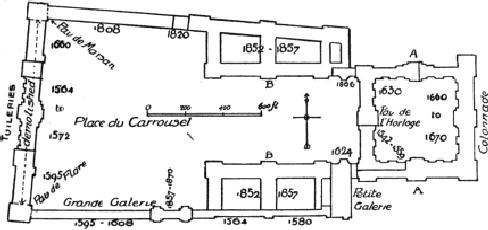
An
important factor in this demoralization
of architectural design has
been the
development
of new constructive methods, especially
in the use of iron and steel. It
has
been impossible for modern
designers, in their treatment of style,
to keep pace
with
the rapid changes in the structural
use of metal in architecture. The
roofs of
vast
span, largely composed of
glass, which modern methods of
trussing have made
possible
for railway stations, armories, and
exhibition buildings; the
immense
unencumbered
spaces which may be covered by them; the
introduction and
development,
especially in the United States, of the
post-and-girder system of
construction
for high buildings, in which the external
walls are a mere screen
or
filling-in;
these have revolutionized
architecture so rapidly and completely
that
architects
are still struggling and
groping to find the solution of many of
the
problems
of style, scale, and composition which
they have brought
forward.
Within
the last thirty years, however,
architecture has, despite
these new conditions,
made
notable advances. The artistic
emulation of repeated international
exhibitions,
the
multiplication of museums and schools of
art, the general advance in
intelligence
and
enlightenment, have all contributed to
this artistic progress. There
appears to be
more
of the artistic and intellectual quality
in the average architecture of the
present
time,
on both sides of the Atlantic, than at any
previous period in this century.
The
futility
of the archæological revival of extinct
styles is generally recognized.
New
conditions
are gradually procuring the
solution of the very problems they
raise.
Historic
precedent sits more lightly on the
architect than formerly, and the
essential
unity
of principle underlying all good
design is coming to be better
understood.26
FIG.
208.--PLAN OF LOUVRE AND TUILERIES,
PARIS.
A,
A, the Old Louvre, so
called; B, B, the New
Louvre.
FRANCE.
It is in
France, Germany (including
Austria), and England that the
architectural
progress of this period in Europe
has been most marked. We
have
already
noticed the results of the classic
revivals in these three
countries. Speaking
broadly,
it may be said that in France the
influence of the École
des Beaux-Arts,
while
it
has tended to give greater
unity and consistency to the national
architecture, and
has
exerted a powerful influence in
behalf of refinement of taste and
correctness of
style,
has also stood in the way of a
free development of new ideas.
French
architecture
has throughout adhered to the
principles of the Renaissance, though
the
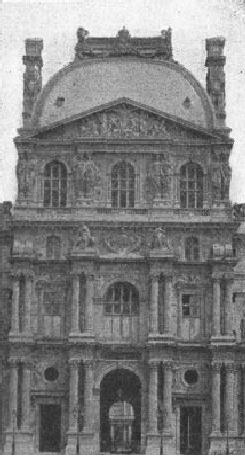
style
has during this century been
modified by various influences. The
first of these
was
the Néo-Grec movement, alluded to in the
last chapter, which broke the
grip of
Roman
tradition in matters of detail and
gave greater elasticity to the
national style.
Next
should be mentioned the Gothic
movement represented by
Viollet-le-Duc,
Lassus,
Ballu, and their followers.
Beginning about 1845, it produced
comparatively
few
notable buildings, but gave a
great impulse to the study of mediæval
archæology
and
the restoration of mediæval monuments.
The churches of Ste. Clothilde and
of
St.
Jean de Belleville, at Paris, and the
reconstruction of the Château de
Pierrefonds,
were
among its direct results.
Indirectly it led to a freer and
more rational
treatment
of
constructive forms and materials than
had prevailed with the academic
designers.
The
church of St.
Augustin, by
Baltard, at
Paris, illustrates this in its
use of iron and
brick
for the dome and vaulting, and the
College
Chaptal, by
E.
Train, in
its
decorative
treatment of brick and tile
externally. The general adoption of iron
for
roof-trusses
and for the construction of markets and
similar buildings tended
further
in
the same direction, the Halles
Centrales at
Paris, by Baltard,
being a notable
example.
FIG.
209.--PAVILION OF RICHELIEU,
LOUVRE.
THE
SECOND EMPIRE. The
reign of Napoleon III. (185270) was
a period of
exceptional
activity, especially in Paris. The
greatest monument of his reign
was the
completion
of the Louvre
and
Tuileries, under
Visconti
and
Lefuel,
including the
remodelling
of the pavilions de Flore and de Marsan.
The new portions constitute the
most
notable example of modern
French architecture, and the manner in
which the
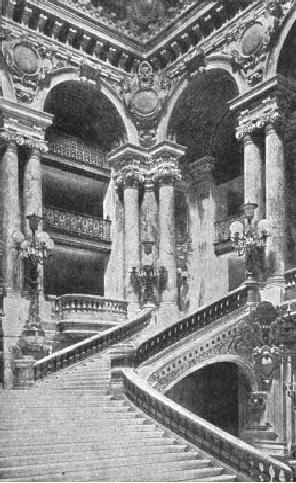
two
palaces were united deserves
high praise. In spite of certain
defects, this work is
marked
by a combination of dignity, richness, and
refinement, such as are
rarely
found
in palace architecture (Figs. 208, 209).
The New
Opera (186375),
by
Garnier
(d. 1898),
stands next to the Louvre in importance
as a national monument.
It
is by far the most sumptuous building for
amusement in existence, but in purity
of
detail
and in the balance and restraint of its
design it is inferior to the work
of
Visconti
and Lefuel (Fig. 210). To this reign
belong the Palais de l'Industrie, by
Viel,
built
for the exhibition of 1855, and several
great railway stations (Gare
du Nord, by
Hitorff,
Gare de l'Est, Gare
d'Orléans, etc.), in which the modern
French version of
the
Renaissance was applied with
considerable skill to buildings
largely constructed
of
iron and glass. Town halls and theatres
were erected in great
numbers, and in
decorative
works like fountains and
monuments the French were
particularly
successful.
The fountains of St.
Michel,
Cuvier, and Molière, at Paris, and
of
Longchamps, at
Marseilles (Fig. 211), illustrate the
fertility of resource and
elegance
of
detailed treatment of the French in this
department. Mention should also
here be
made
of the extensive enterprises carried out
by Napoleon III., in rectifying
and
embellishing
the street-plan of Paris by new avenues
and squares on a vast
scale,
adding
greatly to the monumental splendor of the
city.
FIG.
210.--GRAND STAIRCASE OF THE
OPERA, PARIS.
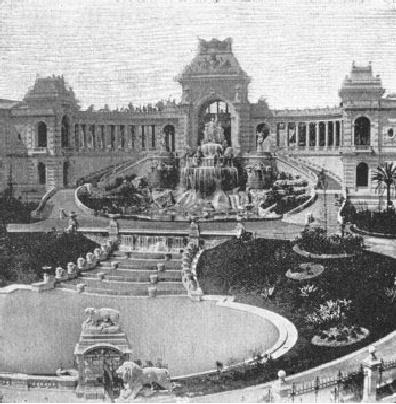
THE
REPUBLIC. Since
the disasters of 1870 a number of important
structures have
been
erected, and French architecture
has shown a remarkable vitality and
flexibility
under
new conditions. Its productions have in
general been marked by a
refined taste
and
a conspicuous absence of eccentricity and
excess; but it has for the most
part
trodden
in well-worn paths. The most
notable recent monuments
are, in church
architecture,
the Sacré-Coeur, at
Montmartre, by Abadie, a
votive church inspired
from
the Franco-Byzantine style of Aquitania;
in civil architecture the new Hôtel
de
Ville, at
Paris, by Ballu
and
Déperthes,
recalling the original structure
destroyed by
the
Commune, but in reality an original
creation of great merit; in
scholastic
architecture
the new École de Médecine, and the new
Sorbonne, by
Nénot, and
in
other
branches of the art the metal-and-glass
exhibition buildings of 1878,
1889,
and
1900. In the last of these the striving
for originality and the effort to
discard
traditional
forms reached the extreme,
although accompanied by much very
clever
detail
and a masterly use of color-decoration.
To these should be added
many
noteworthy
theatres, town-halls, court-houses, and
préfectures
in
provincial cities,
and
commemorative columns and monuments
almost without number. In street
architecture
there is now much more variety and
originality than formerly,
especially
in
private houses, and the reaction
against the orders and against
traditional methods
of
design has of late been
growing stronger. The chief
excellence of modern
French
architecture
lies in its rational
planning, monumental spirit, and
refinement of detail
(Fig.
212).
FIG.
211.--FOUNTAIN OF LONGCHAMPS,
MARSEILLES.
GERMANY
AND AUSTRIA. German
architecture has been more
affected during the
past
fifty years by the archæological spirit
than has the French. A
pronounced
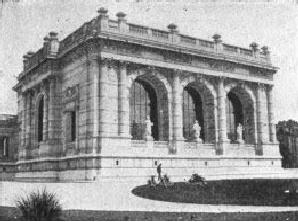
mediæval
revival partly accompanied, partly
followed the Greek revival in
Germany,
and
produced a number of churches and a few
secular buildings in the
basilican,
Romanesque,
and Gothic styles. These are
less interesting than those in the
Greek
style,
because mediæval forms are
even more foreign to modern
needs than the
classic,
being compatible only with systems of
design and construction which are
no
longer
practicable. At Munich the Auekirche, by
Ohlmuller, in an
attenuated Gothic
style;
the Byzantine Ludwigskirche, and
Ziebland's
Basilica
following Early
Christian
models;
the Basilica by Hübsch, at
Bulach, and the Votive Church at
Vienna (1856)
by
H. Von Ferstel (18281883) are
notable neo-mediæval monuments. The
last-
named
church may be classed with Ste. Clothilde
at Paris, and St. Patrick's
Cathedral
at
New York, all three being of
approximately the same size and
general style,
recalling
St. Ouen at Rouen. They are
correct and elaborate, but more or
less cold
and
artificial.
FIG.
212.--MUSÉE GALLIÉRA,
PARIS.
More
successful are many of the German
theatres and concert halls, in
which
Renaissance
and classic forms have been
freely used. In several of
these the attempt
has
been made to express by the
external form the curvilinear plan of the
auditorium,
as
in the Dresden
Theatre, by
Semper
(1841;
Fig. 213), the theatre at Carlsruhe,
by
Hübsch,
and the double winter-summer Victoria
Theatre, at
Berlin, by Titz. But
the
practical
and æsthetic difficulties involved in
this treatment have caused
its general
abandonment.
The Opera
House at
Vienna, by Siccardsburg
and
Van
der Null
(186169),
is rectangular in its masses, and but for
a certain triviality of
detail
would
rank among the most successful
buildings of its kind. The new Burgtheater
in
the
same city is a more elaborately
ornate structure in Renaissance
style, somewhat
florid
and overdone.
Modern
German architecture is at its
best in academic and residential
buildings. The
Bauschule, at
Berlin, by Schinkel, in which brick is
used in a rational and
dignified
design
without the orders; the Polytechnic
School, at Zürich, by Semper;
university
buildings,
and especially buildings for technical
instruction, at Carlsruhe,
Stuttgart,
Strasburg,
Vienna, and other cities, show a
monumental treatment of the exterior
and
of
the general distribution, combined with a
careful study of practical
requirements.
In
administrative buildings the Germans
have hardly been as successful; and the
new
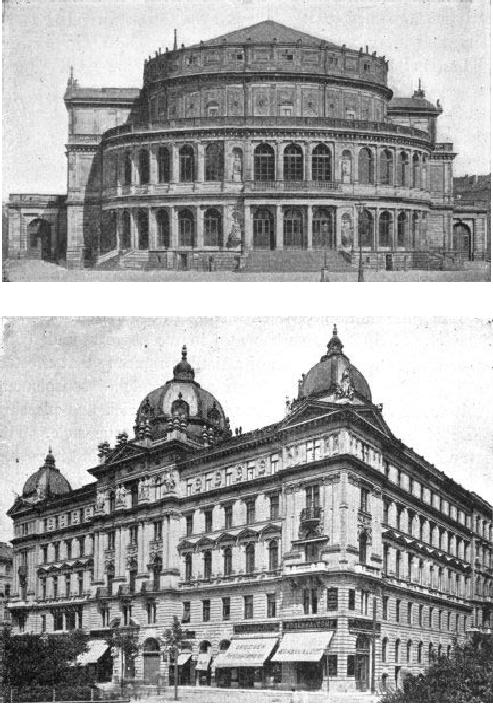
Parliament
House, at
Berlin, by Wallot, in
spite of its splendor and
costliness, is
heavy
and unsatisfactory in detail. The larger
cities, especially Berlin,
contain many
excellent
examples of house architecture,
mostly in the Renaissance style,
sufficiently
monumental
in design, though usually, like most
German work, inclined to
heaviness
of
detail. The too free use of
stucco in imitation of stone is
also open to
criticism.
FIG.
213.--THEATRE AT DRESDEN.
FIG.
214.--BLOCK OF DWELLINGS
(MARIE-THERESIENHOF), VIENNA.
VIENNA.
During the
last thirty years Vienna has
undergone a transformation which
has
made it the rival of Paris as a stately
capital. The remodelling of the
central
portion,
the creation of a series of magnificent
boulevards and squares, and the
grouping
of the chief state and municipal
buildings about these upon a
monumental
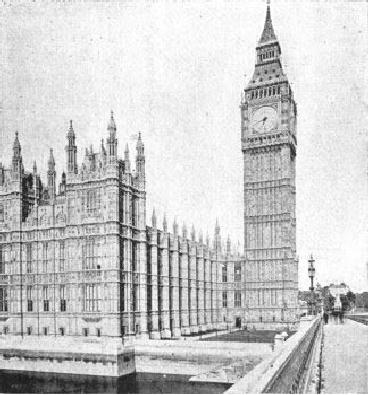
scheme
of arrangement, have given the city an
unusual aspect of splendor.
Among
the
most important monuments in this
group are the Parliament
House, by
Hansen,
and
the Town
Hall, by
Schmidt.
This latter is a Neo-Gothic
edifice of great size
and
pretentiousness,
but strangely thin and meagre in detail,
and quite out of harmony
with
its surroundings. The university and
museums are massive piles in
Renaissance
style;
and it is the Renaissance rather than the
classic or Gothic revival
which
prevails
throughout the new city. The great blocks
of residences and apartments
(Fig.
214)
which line its streets are
highly ornate in their architecture, but
for the most
part
done in stucco, which fails
after all to give the aspect of
solidity and durability
which
it seeks to counterfeit.
The
city of Buda-Pesth
has
also in recent years
undergone a phenomenal
transformation
of a similar nature to that effected in
Vienna, but it possesses
fewer
monuments
of conspicuous architectural interest.
The Synagogue
is the
most noted
of
these, a rich and pleasing edifice of
brick in a modified Hispano-Moresque
style.
FIG.
215.--HOUSES OF PARLIAMENT, WESTMINSTER,
LONDON.
GREAT
BRITAIN. During the
closing years of the Anglo-Greek
style a coterie of
enthusiastic
students of British mediæval
monuments--archæologists rather
than
architects--initiated
a movement for the revival of the
national Gothic
architecture.
The
first fruits of this movement, led by
Pugin, Brandon, Rickman, and
others (about
183040),
were seen in countless
pseudo-Gothic structures in which the
pointed
arches,
buttresses, and clustered shafts of
mediæval architecture were
imitated or
parodied
according to the designer's ability, with
frequent misapprehension of
their
proper
use or significance. This
unintelligent misapplication of Gothic
forms was,
however,
confined to the earlier stages of the
movement. With increasing light
and
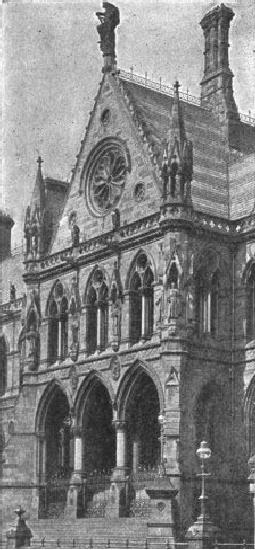
experience
came a more correct and
consistent use of the mediæval
styles, dominated
by
the same spirit of archæological
correctness which had produced the
classicismo
of
the Late Renaissance in Italy. This
spirit, stimulated by extensive
enterprises in
the
restoration of the great mediæval
monuments of the United Kingdom, was
fatal
to
any free and original development of the
style along new lines. But it
rescued
church
architecture from the utter meanness and
debasement into which it had
fallen,
and established a standard of taste which
reacted on all other branches
of
design.
FIG.
216.--ASSIZE COURTS, MANCHESTER.
DETAIL.
THE
VICTORIAN GOTHIC. Between
1850 and 1870 the striving
after
archæological
correctness gave place to the
more rational effort to
adapt Gothic
principles
to modern requirements, instead of
merely copying extinct
styles. This
effort,
prosecuted by a number of architects of
great intelligence, culture,
and
earnestness
(Sir Gilbert Scott, George
Edmund Street, William
Burges, and others),
resulted
in a number of extremely interesting
buildings. Chief among these
in size
and
cost stand the Parliament
Houses at
Westminster, by Sir
Charles Barry (begun
1839),
in the Perpendicular style. This
immense structure (Fig. 215),
imposing in its
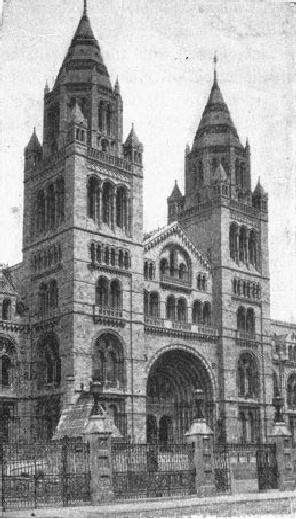
simple
masses and refined in its
carefully studied detail, is the
most successful
monument
of the Victorian Gothic style. It
suffers, however, from the want of
proper
relation
of scale between its
decorative elements and the vast
proportions of the
edifice,
which belittle its component
elements. It cannot, on the whole, be
claimed as
a
successful vindication of the claims of
the promoters of the style as to
the
adaptability
of Gothic forms to structures
planned and built after the
modern
fashion.
The Assize
Courts at
Manchester (Fig. 216), the New
Museum at
Oxford,
the
gorgeous Albert
Memorial at
London, by Scott, and the
New
Law Courts at
London,
by Street,
are all conspicuous illustrations of the
same truth. They are
conscientious,
carefully studied designs in
good taste, and yet wholly unsuited
in
style
to their purpose. They are
like labored and scholarly
verse in a foreign
tongue,
correct
in form and language, but lacking the
naturalness and charm of true and
unfettered
inspiration. A later essay of the
same sort in a slightly
different field is the
Natural
History Museum at
South Kensington, by Waterhouse
(1879), an
imposing
building
in a modified Romanesque style
(Fig. 217).
FIG.
217.--NATURAL HISTORY MUSEUM,
LONDON.
OTHER
WORKS. The
Victorian Gothic style
responded to no deep and
general
movement
of the popular taste, and, like the
Anglo-Greek style, was
doomed to
failure
from the inherent incongruity between
modern needs and mediæval
forms.
Within
the last twenty years there
has been a quite general
return to Renaissance
principles,
and the result is seen in a large number
of town-halls, exchanges,
museums,
and colleges, in which Renaissance forms,
with and without the orders,
have
been treated with increasing
freedom and skilful adaptation to the
materials and
special
requirements of each case. The
Albert Memorial Hall (1863, by
General
Scott)
may be taken as an early instance of this
movement, and the Imperial
Institute
(Colonial
offices), by Collcutt, and Oxford Town Hall, by
Aston Webb, as
among
its latest manifestations. In
domestic architecture the so-called
Queen Anne
style
has been much in vogue, as
practised by Norman Shaw, Ernest
George, and
others.
It is really a modern style,
originating in the imitation of the
modified
Palladian
style as used in the brick
architecture of Queen Anne's
time, but freely and
often
artistically altered to meet
modern tastes and
needs.
In
its emancipation from the mistaken
principles of archæological revivals, and
in its
evidences
of improved taste and awakened
originality, contemporary
British
architecture
shows promise of good things
to come. It is still inferior to the
French in
the
monumental quality, in technical resource
and refinement of decorative
detail.
ELSEWHERE
IN EUROPE. In
other European countries
recent architecture shows
in
general
increasing freedom and improved
good taste, but both its
opportunities and
its
performance have been
nowhere else as conspicuous as in
France, Germany, and
England.
The costly Bourse and the vast but
overloaded Palais de Justice at
Brussels,
by
Polaert,
are neither of them conspicuous for
refined and cultivated taste. A
few
buildings
of note in Switzerland, Russia, and
Greece might find mention in a
more
extended
review of architecture, but cannot
here even be enumerated. In
Italy,
especially
at Rome, Milan, Naples, and Turin, there
has been a great activity
in
building
since 1870, but with the exception of the
Monument
to Victor Emmanuel
and
the National Museum at Rome, monumental
arcades and passages at Milan and
Naples,
and Campi
Santi or
monumental cemeteries at Bologna,
Genoa, and one or
two
other places, there has
been almost nothing of real
importance built in Italy of
late
years.
26.
See
Appendix
D.
Table of Contents:
- PRIMITIVE AND PREHISTORIC ARCHITECTURE:EARLY BEGINNINGS
- EGYPTIAN ARCHITECTURE:LAND AND PEOPLE, THE MIDDLE EMPIRE
- EGYPTIAN ARCHITECTURE—Continued:TEMPLES, CAPITALS
- CHALDÆAN AND ASSYRIAN ARCHITECTURE:ORNAMENT, MONUMENTS
- PERSIAN, LYCIAN AND JEWISH ARCHITECTURE:Jehovah
- GREEK ARCHITECTURE:GENERAL CONSIDERATIONS, THE DORIC
- GREEK ARCHITECTURE—Continued:ARCHAIC PERIOD, THE TRANSITION
- ROMAN ARCHITECTURE:LAND AND PEOPLE, GREEK INFLUENCE
- ROMAN ARCHITECTURE—Continued:IMPERIAL ARCHITECTURE
- EARLY CHRISTIAN ARCHITECTURE:INTRODUCTORY, RAVENNA
- BYZANTINE ARCHITECTURE:DOMES, DECORATION, CARVED DETAILS
- SASSANIAN AND MOHAMMEDAN ARCHITECTURE:ARABIC ARCHITECTURE
- EARLY MEDIÆVAL ARCHITECTURE:LOMBARD STYLE, FLORENCE
- EARLY MEDIÆVAL ARCHITECTURE.—Continued:EARLY CHURCHES, GREAT BRITAIN
- GOTHIC ARCHITECTURE:STRUCTURAL PRINCIPLES, RIBBED VAULTING
- GOTHIC ARCHITECTURE IN FRANCE:STRUCTURAL DEVELOPMENT
- GOTHIC ARCHITECTURE IN GREAT BRITAIN:GENERAL CHARACTER
- GOTHIC ARCHITECTURE IN GERMANY, THE NETHERLANDS, AND SPAIN
- GOTHIC ARCHITECTURE IN ITALY:CLIMATE AND TRADITION, EARLY BUILDINGS.
- EARLY RENAISSANCE ARCHITECTURE IN ITALY:THE CLASSIC REVIVAL, PERIODS
- RENAISSANCE ARCHITECTURE IN ITALY—Continued:BRAMANTE’S WORKS
- RENAISSANCE ARCHITECTURE IN FRANCE:THE TRANSITION, CHURCHES
- RENAISSANCE ARCHITECTURE IN GREAT BRITAIN AND THE NETHERLANDS
- RENAISSANCE ARCHITECTURE IN GERMANY, SPAIN, AND PORTUGAL
- THE CLASSIC REVIVALS IN EUROPE:THE EIGHTEENTH CENTURY
- RECENT ARCHITECTURE IN EUROPE:MODERN CONDITIONS, FRANCE
- ARCHITECTURE IN THE UNITED STATES:GENERAL REMARKS, DWELLINGS
- ORIENTAL ARCHITECTURE:INTRODUCTORY NOTE, CHINESE ARCHITECTURE
- APPENDIX.